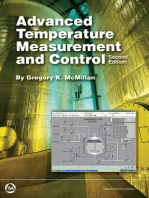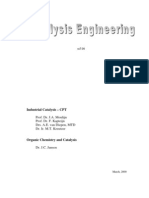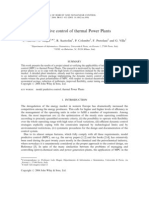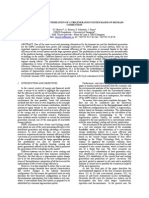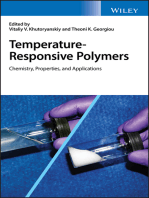Dynamic Modeling and Simulation of Low Density Polyethylene Production - A Comparative Study
Dynamic Modeling and Simulation of Low Density Polyethylene Production - A Comparative Study
Uploaded by
Fatih FıratCopyright:
Available Formats
Dynamic Modeling and Simulation of Low Density Polyethylene Production - A Comparative Study
Dynamic Modeling and Simulation of Low Density Polyethylene Production - A Comparative Study
Uploaded by
Fatih FıratOriginal Description:
Original Title
Copyright
Available Formats
Share this document
Did you find this document useful?
Is this content inappropriate?
Copyright:
Available Formats
Dynamic Modeling and Simulation of Low Density Polyethylene Production - A Comparative Study
Dynamic Modeling and Simulation of Low Density Polyethylene Production - A Comparative Study
Uploaded by
Fatih FıratCopyright:
Available Formats
SN E T
E C H N I C A L
O T E
Dynamic Modeling and Simulation of Low Density Polyethylene
Production A Comparative Study
Ilknur Disli1, Achim Kienle1,2*
Institut fur Automatisierungstechnik, Otto-von-Guericke-UniversitatMagdeburg, Postfach 4120,
39106 Magdeburg, Germany; *achim.kienle@e-technik.uni-magdeburg.de
2
Max-Planck-Institut fur Dynamik komplexer technischer Systeme, Magdeburg, Germany
1
Abstract. This study deals with the modelling and simulation of low density polyethylene (LDPE) production. LDPE
is one of the most widely produced polymers which appears in the form of simple goods in our everyday life (e.g.
food and pharmaceutical packaging, carrier bags). It is
produced in a complex industrial process which takes
place under extreme operating conditions (at pressure of
ca. 2000-3000 bar) and may lead to nonlinear dynamics
due to highly exothermic addition polymerization reactions. In principle, the process is represented by a distributed system with an external coordinate (the reactor
length > 1000m) and various internal coordinates (the
chain length of the polymer molecules, short and long
chain branching and the number of double bounds), which
can have strong effect on product properties. In this contribution a detailed reference model is introduced and
possible model simplifications are discussed systematically
from an on-line optimization and control point of view.
Introduction
Low density polyethylene (LDPE) is one of the most
widely produced polymers which appears in the form of
simple goods in our everyday life (e.g. food and pharmaceutical packaging, carrier bags). It is produced in a
complex industrial process which takes place under
extreme operating conditions (at pressure between
2000-3000 bar). It can show intricate nonlinear dynamic
behaviour due to the high exothermicity of the chemical
reaction in combination with some internal recycle
loops [7, 8], which requires some stabilizing control.
Usually, such a plant receives the raw materials from
upstream processes which may cause load changes in
the LDPE plant. It is important to maintain the product
quality in the face of such load changes. Furthermore, in
such a plant, typically more than 15 different grades of
product with different product properties (density, melt
flow index etc.) may be produced.
In order to follow frequently changing market demands it is necessary to follow an optimum grade transition policy during manufacturing different polymer
while maintaining a profitable operation.
These issues emphasize the significance of control
tasks for the LDPE plant and subsequently the significance of suitable process models which can be employed for control purposes. First attempts on optimization based control were based on steady state models
only [4]. However more recently it is possible to use
dynamic optimization methodswithin the framework of
nonlinear model predictive control (NMPC) based on
dynamic models. Although first steps have been made
in this direction [9], the size of the mathematical model
arising from the distributed nature of the LDPE plant
remains a challenging issue.
The objective of this study is to provide a benchmark model of the LDPE plant with a reasonablemodel
size which can be useful for optimal control approaches.
Therefore first a detailed reference model developed in
our group [2, 1] is reviewed and then possible model
simplifications are introduced systematically. The reference model of the LDPE plant is represented by a distributed system with an external coordinate (the reactor
length > 1000 m) and various internal coordinates (the
chain length of the polymer molecules, short and long
chain branching and the number of double bounds),
which can have strong effect on product properties.
This model describes the heat transfer in detail in
addition to including material recycles, both of which
are shown to have influence on the plant dynamics. The
experience gained on the process via reference model is
used to make necessary model simplifications. The
simulation with the suggested simple model are carried
out to analyse the effects of heat transfer, the types of
initiators and modifier on the state profiles and product
properties. Results of the simple and reference models
are compared and conclusions are drawn.
SNE Simulation Notes Europe Print ISSN 2305-9974 | Online ISSN 2306-0271
SNE 22(3-4), 2012, 1141-146 | doi: 10.11128/sne.22.tn.10145
SNE 22(3-4) 12/2012 141
A Kienle et al.
TN
Dynamic Modeling and Simulation Polyethylene Production
1 Process Description
The flow diagram of the process, which is shown in
Figure 1, includes a tubular reactor, some peripheral
units such as compressors, separators, heat exchangers,
mixers, two recycle streams. The tubular reactor of
ethylene polymerization (i.e. LDPE production) operates under high pressures between 2000 and 3000 bar.
Reactor temperature along the reactor varies between
400 K and 600 K. Such a reactor is usually very long
( > 1000 m ) and has a small diameter with a large ratio
of length to diameter such as 25000.
The feed stream to the reactor consists of high purity
ethylene as monomer and a suitable modifier (chain
transfer agent). Most often a mixture of peroxides is
used as initiator and fed at four injection points along
the reactor. Feed stream to the reactor is first preheated
then its pressure is raised to the required value through
the compressors. The addition polymerization reactions
shown in Table 1 are initiated by decomposition of
initiators around the injection positions. Typically ethylene polymerization is highly exothermic such that the
heat released during the process is required to be removed partially by cooling jackets . Right after each
initiator injection point there exist four cooling jackets.
Furthermore, in order to keep the reactor temperature below the allowed maximum value, the conversion
in the reactor is kept low by adjusting the initiator flow
rates in addition to using the available cooling capacity.
The polymer product, LDPE, is withdrawn from the last
separator whereas the unreacted ethylene and modifier
are recycled from both separators to the inlet of the
reactor to be mixed with the fresh feed.
reaction mechanism is considered. In peripheral units
quasi-stationary energy balance and well mixed fluids
are assumed. The chemical reactions of free radical
addition polymerization are shown in Table 1.
The polymer product, LDPE, includes polymer molecules of different chain lengths. It is necessary that the
chain length distribution of the product should be described. For this purpose, the method of moments is
used by including only the first 3 moment balances of
dead and live polymer molecules.
Figure 1. Flow diagram of LDPE plant.
The tubular reactor is represented by 16 modules in
series. Each module comprises a part of reactor and a
countercurrent coolant cycle around it. The model describes the heat transfer in detail in addition to including
material recycles, both of which are shown to have
influence on the plant dynamics. Model equations based
on momentum, mass and energy balances are summarized for one reactor module as follows:
Reactor:
+ ( , )
+ ( , )
142 SNE 22(3-4) 12/2012
2 Reference Model
A detailed reference dynamic model of the LDPE production plant has been developed in our group [2, 1].
The process is represented by a distributed system with
an external coordinate (the reactor length of 2 km) and
various internal coordinates (the chain length of the
polymer molecules, short and long chain branching and
the number of double bounds), which can have strong
effect on product properties.
In the reactor it is assumed that: (i) ethylenepolyethylene mixture is homogeneous; (ii) there exist
only liquid phase flowing in plug-flow mode without
axial mixing; (iii) physical properties are function of
temperature, pressure and composition; (iv) quasistationary pressure dynamics is valid; (v) a detailed
<
)
+ ( , )
Coolant cycle:
(2)
(3)
+ ( , )
(1)
( , ).
Wall:
< , = 1, . ,
(4)
=
)
(5)
There z is the axial coordinate; L is the total length of a
reactor section and t is the time; is the axial velocity of
the reaction fluid; is the stoichiometric coefficient; j is
the index for reaction; r is the rate of reaction; Hr is
the heat of reaction;
is the mass flow through the
cross section of the tubular reactor with diameter d; ,
Cp, U are density, heat capacity and heat transfer coefficient at different layers.
TN
A Kienle et al.
Dynamic Modeling and Simulation Polyethylene Production
Hafele et al. [1] further studied the influence of the heat
transfer through reactor wall
and the influence of material
recycles on the plant dynamics.
It has been shown that: (i) the
heat transfer through thick
reactor wall dominates the time
constant of the reactor; (ii) by
including the material recycles
the time constant is significantly
Table 1: Reaction mechanism : I represents the initiator, I* is the initiator radical,
increased and in some cases
M is the monomer, R is the growing or live polymer radical, P is the dead polymer,
they give rise to intricate nonn and m denote the degree of polymerization.
linear behaviour.
The state vector xi represents weight fraction of monoIn general, the detailed model represents the steady state
mer, initiators, modifier, and related radicals, moments
and dynamic behaviour of the industrial LDPE plant
of living and dead polymer chains. The state vectors T,
very well.
TW, TC, Tamb, represent temperatures of reaction fluid,
However the size of the model is required to be rereactor wall, cooling medium and ambient air respecduced in order to carry out on-line optimization and
tively.
control studies within a reasonable computation time.
The balance equations for one reactor module result
Therefore in the following section a simplified version
in a set of 30 partial differential and algebraic equations
is proposed.
(PDAEs). The peripheral units are represented by dif3 Simple Model
ferential algebraic equation systems (DAE). The simulation of the dynamic behaviour of the process is done
The simple model of the LDPE plant is based on the
within the flow-sheet simulation package DIVA [6]. As
mass and energy balances. Main simplifications are
a priory to that the PDAE system is transformed to a
done on the plant flow-diagram, the reaction mechanism
DAE system by using the adaptive method of line with
and the energy balance in addition to some other model
finite difference scheme.After discretization of the spaassumptions.
tial coordinate (60 grid points for one module) the final
Simplified plant flow-diagram. The simplified flow
DAE system consists of approximately 30000 dynamic
diagram of the LDPE plant is shown in Figure 3. It
and state variables [1].
comprises a tubular reactor with four modules in series,
This model was validated successfully by showing
one flash unit and one recycle stream. The operating
very good agreement with steady state data available
conditions are the same as in the case of detailed model.
from industrial partners. The steady state temperature and
conversion profiles are shown Figure 2.
Figure 2. Detailed model - Dimensionless steady state
temperature and conversion profiles along the reactor.
Simplified reaction mechanism. The reaction mechanism of the simple model includes the main reactions
which are highlighted in grey colour in Table 1 whereas
the detailed plant model considers all reactions listed
there. Kinetic parameters are given in Table 2 .
Simplified energy balance. It is assumed that (i) the
overall heat transfer coefficient U has a constant value
in each reactor module ; (ii) the cooling temperature Tc
is constant along the whole cooling jacket. These lead to
neglecting the energy balance equations on the coolant
medium and the reactor wall side.
SNE 22(3-4) 12/2012 143
A Kienle et al.
Dynamic Modeling and Simulation Polyethylene Production
Additionally, the following assumptions hold: one
phase (liquid) flow; no axial dispersion (plug flow);
constant pressure drop; constant physical properties;
negligible time delay between peripheral units; constant
temperature in the recycle; ideal separation in the flash
unit. Mass and energy balances for both flash and mixer
units are assumed to be quasi-stationary.
3.1 Model Equations
The model equations for one reactor module, which
comprises a part of the reactor between two initiator
injection points and one counter current coolant cycle
around it, are given as follows:
=
<
< , = 1, ,
(6)
) (7)
The boundary conditions:
Ci(0,t)=Ci,in(t) T(0,t)=Tin(t)
The initial conditions:
T(0,t)=Tin(t)
Ci(z,0)=Ci,0(z)
The state vector Ci represents concentrations of monomer, initiators, modifier and related radicals, moments
of living and dead polymer chains. The state vector T
represents the reactortemperature. The method of moments is used to represent the progress of the reaction in
terms of the leading moments of the chain length distribution of the live and dead polymer chains. These
moments are defined by the following equations:
(8)
where i and i are the ith moments of the living polymer and the dead polymer chains respectively.
0th moment corresponds to the total concentration of
the polymer. 1st and and 2nd moments are used to characterize the molecular weight distribution, e.g. the number average chain length, NACL, also known as degree
of polymerization, DPn, and the polydispersity, PD:
=
=(
/
)/( )
(9)
(10)
If one is interested only in the stability control of the
plant then the reactor model with 0th moment is satisfactory. On the other hand, the product quality information
(e.g. NACL and PD) is crucial for grade transition control problems.
144 SNE 22(3-4) 12/2012
TN
It requires to include at least 3 leading moments (0th,
1 and 2nd) in the model equations. Accordingly the
size of the model will increase.
The simple model formulation (with 3 leading moments) consists of a set of 14 PDAE per reactor module.
After transforming this PDAE system into a DAE system, simulations are carried out within the flow-sheet
simulation package DIVA [6]. The results of the simple
model are presented in the following section.
st
3.2 Results
Results obtained from simulations of the simple model
are presented for 4 different cases.
In Case I, II and III, the effects of the overall heat
transfer coefficient and the types of initiators on steady
state profiles are shown. In these cases the reaction
mechanism includes only the main reactions listed in
Table 1. Case IV includes additionally the reaction
related to the modifier consumption and aims to show
the influence of modifier on product properties. The
results obtained in each case are compared to those of
the reference model.
Case I.
In Case I, it is assumed that: (i) one type of initiator
with a constant flow-rate is fed at each injection point;
(ii) the heat transfer coefficient U has the same constant
value in all four modules. The steady state profiles of
temperature and concentration along the reactor are
illustrated in Figure 4. The reference model profiles are
represented by red solid lines, the state profiles of the
simple model-Case I by blue dashed-dotted lines. Results of the Case I are qualitatively in agreement with
the detailed model but there exists a large deviation
from reference state profiles.
This is not unexpected due to many simplifying assumptions made . In the next step these assumptions
will be modified by considering the behaviour of the
reference model.
Case II
In Case II, the effect of the heat transfer coefficient U
on the steady state profiles is shown. The detailed model
results indicate that U decreases along the reactor. Consequently, for the simple model, U will be specified at a
different mean value in each reactor module but in a
decreasing manner hrough the end of the reactor. The
assumption of using one type of initiator in eachmodule
is still valid. The resulting profiles of Case II are illustrated in Figure 4 by pink dashed lines. It can be noted
TN
A Kienle et al.
Dynamic Modeling and Simulation Polyethylene Production
that some improvement is obtained for the temperature
profile of the simple model especially through the end
of the reactor. However, a considerable large offset still
remains between the states of simple and reference
models.
Case III
Conversion
NACL
Polydispersity
Simple model (Case III)
(no modifier)
0.876
17.18
2.81
Simple model (Case IV)
(With modifier)
0.876
0.99
0.49
Table 3. Product quality values relative to the
In Case III, a mixture of two types of initiators is used at
reference model
each injection point, which is a more realistic approach.
Additionally kinetic parameters of initiator
decomposition reaction are taken from the
reference model. The condition on the
parameter U is the same as in Case II: U is
kept constant at a different value in each
reactor module. The results of Case III are
demonstrated in Figure 4 by black solid
lines. It is shown that almost perfect
agreement is obtained quantitatively between the state profiles of simple and reference models.
At this point, a question arises about the
Figure 3. Simplified flow diagram of LDPE plant.
product quality. Conversion,NACL and
PD, are given in Table 3. Although the
ethylene conversion approximately agrees
for the reference model and the simple
model (Case-III), there is a considerable
deviation in NACL and PD values. This is
due to neglecting all side reactions of the
reaction mechanism up to this point. Side
reactions have functions to stop a growing
polymer chain or to cause branching along
a polymer chain etc. In the next step, the
most important side reaction will be consider in the reaction mechanism of the
simple model.
Table 2. Kinetic rate constants: a Kim and Iedema [3],b Lee and Marano [5]
Case IV
In Case IV, the conditions are the same as
in Case III except that the reaction mechanism is extended by including the chain
transfer reaction to the modifier which is
responsible to regulate the chain length of
the polymer molecules. The state profiles
obtained in Case IV are the same as in Case
III. Moreover, NACL and PD values are
improved considerably (see Table 3). Especially NACL with a realtive value of
0.99 is very close to that of thereference
model.
Figure 4. Dimensionless steady state temperature and
conversion profiles along the reactor : Red continuous line - Detailed model;
Dashed line - Simple model-I; Dashed and dotted line- Simple model-II;
Black continuous line Simple model-III.
SNE 22(3-4) 12/2012 145
A Kienle et al.
Dynamic Modeling and Simulation Polyethylene Production
TN
As a result of these four case studies, it can be concluded that the simple model with the conditions applied
in Case IV represents the LDPE production process
reasonably well close to the reference states and product
properties. It can be used in principle research for grade
transition.
which has a much smaller size than reference model
works fine except some small deviations and has potential for stabilizing control studies. Considering that it
also provides product properties at least in a qualitative
way, the simple model can be used in principle research
for grade transition control.
Model Sizes.
References
There may be some differences in the model sizes
among the cases studied above. This depends on (i) the
number of initiators - whether one type or a mixture of
few types of initiators is used ; (ii) whether the modifier
reaction is included or not. (iii) the number of leading
moments included. However, any version of the simple
models has a much smaller size then the reference model.
The comparison of the model sizes for reference and
simple models are given in Table 4. The order of the
ODAE system for the simple model-Case IV is 5600
which is reduced by a factor of 5 comparing to the order
of 30000 in the case of reference model. If one is interested in only stability control of the plant, then one
should use a simple model with only 0th moments,
which will result in a model with an order of 2400.
Reference
Model
Simple
model
Simple
model
[2,1]
Case IV
0th moment
Number of
reactor module
16
Order of
PDAE sys
30
/ module
14
/ module
Equidistant
grid points
60
/module
100
/ module
100
/ module
Oder of the
ODAE sys
30000
5600
2400
Table 4. Comparison of model sizes.
4 Conclusions
In this study a detailed reference model was introduced
and possible model simplifications were discussed systematically from an on-line optimization and control
point of view. The simulation with the suggested simple
model were carried out to analyse the effects of the
overall heat transfer coefficient, the types of initiators
and modifier on the state profiles and product properties. The simple model was validated by comparing with
the reference model. It was shown that the simple model
146 SNE 22(3-4) 12/2012
[1] M. Hafele, M., Kienle, A., Boll, M., and Schmidt, C.-U.
(2006). Modeling and analysis of a plant for the production of low-density polyethylene. Comput. Chem.
Engng., 31, 5165.
[2] M. Hafele, M., Kienle, A., Boll, M., Schmidt, C.-U., and
Schwibach, M. (2005). Dynamic simulation of a tubular
reactor for the production of low-density polyethylene
using adaptive method of lines. J. Computational and
Appl. Math., 183(2), 288300.
[3] Kim, D.-M., and Iedema, P.(2004). Molecular weight
distribution in low-density polyethylene polymerization ;
impaxsct of scission mechanism in the case of a tubular
reactor. Chem. Eng. Sci., 59, 20392052.
[4] Kiparissides, C., Verros, G., and MacGregor, J. (1993).
Mathematical modeling, optimization and quality control
of high-pressure ethylene polymerization reactors. J. of
Macromol. Sci.-Rev. Macromol.Chem. Phys., C33(4),
437527.
[5] Lee, K., and Marano, J. (1979). Free-radical polymerization: sensitivity of conversion and molecularweights to
reaction conditions. ACS Symp.Ser., 104, 221251.
[6] Mangold, M., Kienle, A., Mohl, K., and Gilles, E.(2000).
Nonlinear computation in diva - methods and applications. Chem. Eng. Sci., 55, 441454.
[7] Pushpavanam, S., and Kienle, A. (2001. Nonlinear behavior of an ideal reactor separator network with mass
recycle. Chem. Eng. Sci., 56, 28372849.
[8] Ray, W., and Villa, C. (2000). Nonlinear dynamics
found in polymerization processes - a review. Chem.
Eng. Sci., 55, 275290.
[9] Zavala, V., and Villa, C. (2008). Large-scale nonlinear
programming strategies for the operation of low-density
polyethylene tubular reactors. In Proc. ESCAPE-18,
Lyon, France, 629634.
Submitted MATHMOD 2009: November 2008
Accepted MATHMOD 2009: January 2009
Submitted SNE: January 2010
Accepted: February 5, 2010
You might also like
- Honda BF15A Owners Manual Outboard MotorDocument88 pagesHonda BF15A Owners Manual Outboard MotorRicardo VilhenaNo ratings yet
- Advanced Temperature Measurement and Control, Second EditionFrom EverandAdvanced Temperature Measurement and Control, Second EditionNo ratings yet
- Ethanol Amine Production PDFDocument8 pagesEthanol Amine Production PDFFatih FıratNo ratings yet
- UTD - Spring 2023 CS 4347 Database Systems Assignment #5 Due On 03/31/23, 11.59pmDocument4 pagesUTD - Spring 2023 CS 4347 Database Systems Assignment #5 Due On 03/31/23, 11.59pmPhương NguyễnNo ratings yet
- A Mathematical Model For The Production of Low Density Polyethylene in A Tubular ReactorDocument8 pagesA Mathematical Model For The Production of Low Density Polyethylene in A Tubular ReactorAlfredo IllescasNo ratings yet
- 1 PatenteDocument10 pages1 PatenteEmanuel Valenzuela CasimiroNo ratings yet
- Dynamic Simulation of A PVC Suspension Reactor A. Dimian, D. Diepen, G. ADocument6 pagesDynamic Simulation of A PVC Suspension Reactor A. Dimian, D. Diepen, G. Amatheus735No ratings yet
- A Comprehensive Investigation On High-Pressure LDPE Manufacturing: Dynamic Modelling of Compressor, Reactor and Separation UnitsDocument6 pagesA Comprehensive Investigation On High-Pressure LDPE Manufacturing: Dynamic Modelling of Compressor, Reactor and Separation UnitsAbdul SamadNo ratings yet
- Comprehensive Investigation On High Pressure Ldpe Manufacturing - Dynamic Modeling of Compressor, Reactor, SeparatorDocument10 pagesComprehensive Investigation On High Pressure Ldpe Manufacturing - Dynamic Modeling of Compressor, Reactor, Separatorsswoo8245No ratings yet
- 9fcfd50cb5f2d7fda1 PDFDocument15 pages9fcfd50cb5f2d7fda1 PDFIbrahim LahmidNo ratings yet
- Syngas 2MeOHDocument10 pagesSyngas 2MeOHDaniil GhilescuNo ratings yet
- Low Density Polyethylene Tubular Reactor Modeling: Overview of The Model Developments and Future DirectionsDocument8 pagesLow Density Polyethylene Tubular Reactor Modeling: Overview of The Model Developments and Future DirectionsAleidinNo ratings yet
- DME Synthesis Via Catalytic Distillation: Experiments and SimulationDocument6 pagesDME Synthesis Via Catalytic Distillation: Experiments and SimulationediabcNo ratings yet
- Chapter One: 1.1 BackgroundDocument19 pagesChapter One: 1.1 BackgroundteweleNo ratings yet
- Chapter One: 1.1 BackgroundDocument22 pagesChapter One: 1.1 BackgroundteweleNo ratings yet
- Ijs Mitol Escape18Document6 pagesIjs Mitol Escape18Lavinia BocănealăNo ratings yet
- Dynamic Model Used To Investigate The Influence of Operating Conditions On The Behavior of Commercial PemfcDocument8 pagesDynamic Model Used To Investigate The Influence of Operating Conditions On The Behavior of Commercial Pemfc10 000 de cartiNo ratings yet
- Applied Thermodynamics For Process ModelingDocument7 pagesApplied Thermodynamics For Process ModelingdhavalmpNo ratings yet
- Steady-State and Dynamic Modeling of The Basell Multireactor Olefin Polymerization ProcessDocument10 pagesSteady-State and Dynamic Modeling of The Basell Multireactor Olefin Polymerization ProcessAhmadNo ratings yet
- Emulsion Polymerization Process Control: November 2011Document6 pagesEmulsion Polymerization Process Control: November 2011jesus armando lopezNo ratings yet
- M. Gandiglio, A. Lanzini, M. Santarelli, P. Leone, R. Borchiellini Politecnico Di Torino, Corso Duca Degli Abruzzi 24, 10129, Torino, Italy Corresponding AuthorDocument14 pagesM. Gandiglio, A. Lanzini, M. Santarelli, P. Leone, R. Borchiellini Politecnico Di Torino, Corso Duca Degli Abruzzi 24, 10129, Torino, Italy Corresponding AuthoradrianunteaNo ratings yet
- Dynamic Modeling and Simulation of A #Uidized Catalytic Cracking Process. Part II: Property Estimation and SimulationDocument18 pagesDynamic Modeling and Simulation of A #Uidized Catalytic Cracking Process. Part II: Property Estimation and SimulationHoang-Vu BuiNo ratings yet
- Kim 2015Document39 pagesKim 2015reclatis14100% (1)
- Furnace DimensionsDocument16 pagesFurnace DimensionsAbdulrahman ezzaldeenNo ratings yet
- An Experimental Approach To The Modeling of PEM Fuel Cells in Dynamic ConditionsDocument6 pagesAn Experimental Approach To The Modeling of PEM Fuel Cells in Dynamic ConditionsMircea RaceanuNo ratings yet
- A New Lumping Kinetic Model For Fluid Catalytic Cracking: Petroleum Science and TechnologyDocument8 pagesA New Lumping Kinetic Model For Fluid Catalytic Cracking: Petroleum Science and Technologysalim salimNo ratings yet
- Organic Rankine CycleDocument14 pagesOrganic Rankine Cycleoverlord5555No ratings yet
- Degradation PPDocument33 pagesDegradation PPJohnStratigakisNo ratings yet
- Full Bioethylene Process - 2019-07-04 - Revised - UnmarkedDocument54 pagesFull Bioethylene Process - 2019-07-04 - Revised - UnmarkedKashaf TehreemNo ratings yet
- Simulation of An Isothermal Catalytic Membrane Reactor For The Dehydrogenation of ETHYLBENZENEDocument16 pagesSimulation of An Isothermal Catalytic Membrane Reactor For The Dehydrogenation of ETHYLBENZENEVassiliNo ratings yet
- Luyben 2009Document12 pagesLuyben 2009Cefiro Santibañez VelasquezNo ratings yet
- Lucca Et Al-2008-Macromolecular Symposia PDFDocument7 pagesLucca Et Al-2008-Macromolecular Symposia PDFAhmadNo ratings yet
- Project Report NewDocument41 pagesProject Report Newrohith reddyNo ratings yet
- Energy Systems - Fuel CellDocument15 pagesEnergy Systems - Fuel Celleoghan mulliganNo ratings yet
- CJChE-22-0058 Revised Manuscript FINALDocument27 pagesCJChE-22-0058 Revised Manuscript FINALEdwardNo ratings yet
- Reactor Design PDFDocument13 pagesReactor Design PDFOmesh BoroleNo ratings yet
- Lecture Notes Catalysis EngineeringDocument221 pagesLecture Notes Catalysis Engineeringburbuja412100% (1)
- Optimization of Methanol Synthesis Reactor Using Genetic AlgorithmsDocument7 pagesOptimization of Methanol Synthesis Reactor Using Genetic AlgorithmsDante PhaseNo ratings yet
- Development of A Microcogeneration Laboratory and Testing of A Natural Gas CHP Unit Based On Pem Fuel CellsDocument9 pagesDevelopment of A Microcogeneration Laboratory and Testing of A Natural Gas CHP Unit Based On Pem Fuel CellsAdrianUnteaNo ratings yet
- 2 Phase Gas Phase PolymerizationDocument10 pages2 Phase Gas Phase Polymerizationrmehta26No ratings yet
- CENG 1004: Introduction To Chemical Engineering Synopsis: Prof A GavriilidisDocument78 pagesCENG 1004: Introduction To Chemical Engineering Synopsis: Prof A GavriilidisMatthew AdeyinkaNo ratings yet
- A Simple-To-Implement Simulator For The Reactive Extrusion of PLADocument14 pagesA Simple-To-Implement Simulator For The Reactive Extrusion of PLAIrma BrennanNo ratings yet
- Chemical Engineering JournalDocument10 pagesChemical Engineering JournalbabithyNo ratings yet
- Experimental and Modelling Studies of Low Temperature PEMFC PerformanceDocument10 pagesExperimental and Modelling Studies of Low Temperature PEMFC PerformanceiocsachinNo ratings yet
- Predictive Control of Thermal Power Plants: C. Aurora, L. Magni, R. Scattolini, P. Colombo, F. Pretolani and G. VillaDocument19 pagesPredictive Control of Thermal Power Plants: C. Aurora, L. Magni, R. Scattolini, P. Colombo, F. Pretolani and G. Villamihai_draganescu3601No ratings yet
- Thermodynamic Optimization of A Trigeneration System Based On Biomass CombustionDocument9 pagesThermodynamic Optimization of A Trigeneration System Based On Biomass CombustionTiago HenriquesNo ratings yet
- Conceptual Modelling and Optimization of Jacketed Tubular Reactors For The Production of LDPEDocument6 pagesConceptual Modelling and Optimization of Jacketed Tubular Reactors For The Production of LDPECheak TingNo ratings yet
- Fluidized Bed ReactorDocument20 pagesFluidized Bed ReactormarraezNo ratings yet
- ! 19 Organic Rankine CycleDocument14 pages! 19 Organic Rankine Cyclesapcuta16smenNo ratings yet
- Modeling and Simulation of Low Density Polyethylene (LDPE) High Pressure Tubular ReactorDocument9 pagesModeling and Simulation of Low Density Polyethylene (LDPE) High Pressure Tubular ReactorJuan Carlos BeltranNo ratings yet
- BTG Controls 73Document8 pagesBTG Controls 73Anil PandeyNo ratings yet
- A Transient Study of Double-Jacketed Membrane Reactor Via Methanol Steam ReformingDocument9 pagesA Transient Study of Double-Jacketed Membrane Reactor Via Methanol Steam Reformingmerialeng34No ratings yet
- 10 1021@ie0107643Document7 pages10 1021@ie0107643noviNo ratings yet
- Polypropylene Production Simulation With Cape-Open Interfacing of Pro/ii and gPROMSDocument15 pagesPolypropylene Production Simulation With Cape-Open Interfacing of Pro/ii and gPROMSAhmadNo ratings yet
- Control Schemes For Low Density Polyethylene ReactorDocument6 pagesControl Schemes For Low Density Polyethylene ReactorAlfredo CastilloNo ratings yet
- 3D Unsteady Simulation of A Scale-Up Methanation RDocument19 pages3D Unsteady Simulation of A Scale-Up Methanation RVirender SehwagNo ratings yet
- Implementation of Optimal Operation For Heat Integrated Distillation ColumnsDocument5 pagesImplementation of Optimal Operation For Heat Integrated Distillation ColumnsbiniyamNo ratings yet
- Model Evaluation For An Industrial Process of Direct Chlorination of Ethylene in A Bubble-Column Reactor With External Reci PDFDocument11 pagesModel Evaluation For An Industrial Process of Direct Chlorination of Ethylene in A Bubble-Column Reactor With External Reci PDFyamakunNo ratings yet
- Process Control Unit 4 NotesDocument21 pagesProcess Control Unit 4 NotesiamananujrNo ratings yet
- Sustainable synthesis of ciclopentene derivatives through multicomponent reactions in continuous flow regimeFrom EverandSustainable synthesis of ciclopentene derivatives through multicomponent reactions in continuous flow regimeNo ratings yet
- Temperature-Responsive Polymers: Chemistry, Properties, and ApplicationsFrom EverandTemperature-Responsive Polymers: Chemistry, Properties, and ApplicationsNo ratings yet
- Polymers in Regenerative Medicine: Biomedical Applications from Nano- to Macro-StructuresFrom EverandPolymers in Regenerative Medicine: Biomedical Applications from Nano- to Macro-StructuresNo ratings yet
- API 620 Appendix R Tanks For Storage of Refrigerated Product PDFDocument16 pagesAPI 620 Appendix R Tanks For Storage of Refrigerated Product PDFFatih FıratNo ratings yet
- Improved Control Valve Sizing For Multiphase FlowDocument5 pagesImproved Control Valve Sizing For Multiphase FlowFatih FıratNo ratings yet
- Maersk Olie Og Gas AS Esplanaden 50 DK-1263 Copenhagen K. Denmark Attn. Mr. L. AnderssonDocument21 pagesMaersk Olie Og Gas AS Esplanaden 50 DK-1263 Copenhagen K. Denmark Attn. Mr. L. AnderssonFatih FıratNo ratings yet
- Ethanol Amine ProductionDocument8 pagesEthanol Amine ProductionFatih FıratNo ratings yet
- Ejector Data SheetDocument5 pagesEjector Data SheetFatih FıratNo ratings yet
- DWC Column SimulationDocument14 pagesDWC Column SimulationFatih FıratNo ratings yet
- Heat Exchanger Input Correction FactorDocument11 pagesHeat Exchanger Input Correction FactorFatih FıratNo ratings yet
- Catalyst To EthanolDocument26 pagesCatalyst To EthanolFatih FıratNo ratings yet
- Venturi CD at Laminar FlowDocument6 pagesVenturi CD at Laminar FlowFatih Fırat100% (1)
- Display Devices: Stanislovas - Staras@el - Vgtu.ltDocument75 pagesDisplay Devices: Stanislovas - Staras@el - Vgtu.ltlizhi0007No ratings yet
- U3 M2 Quiz 2Document10 pagesU3 M2 Quiz 2michelaguilar12No ratings yet
- Scraptacular Frog Amigurumi Crochet PatternDocument9 pagesScraptacular Frog Amigurumi Crochet PatternyouaremyinoriNo ratings yet
- Great Gatsby AnalysisDocument6 pagesGreat Gatsby Analysis7arthakendroNo ratings yet
- CCU J. Modbus Variables ListDocument6 pagesCCU J. Modbus Variables ListJitendra PathakNo ratings yet
- Tender To Set Up Computer Lab in Learning Institutions: 1. Bid SubmissionDocument12 pagesTender To Set Up Computer Lab in Learning Institutions: 1. Bid Submissionkalai arasanNo ratings yet
- Iaea TRS 469 PDFDocument86 pagesIaea TRS 469 PDFClaudia Morales UlloaNo ratings yet
- Project Title: Timber Harvesting SystemDocument32 pagesProject Title: Timber Harvesting SystemParthu djgaNo ratings yet
- Manipulating Darts Shirley Adams Sewing ConnectionDocument5 pagesManipulating Darts Shirley Adams Sewing ConnectionJS100% (2)
- Alessi Warm Up For TromboneDocument8 pagesAlessi Warm Up For Trombonelicxido corderoNo ratings yet
- PATHFit 1 Module 1 AY 2023 2024Document23 pagesPATHFit 1 Module 1 AY 2023 2024Jerald BarandinoNo ratings yet
- Position FixDocument29 pagesPosition FixPanagiotis Mouzenidis100% (1)
- Novel Empirical Model of Rubber Bushing in Automotive Suspension SystemDocument16 pagesNovel Empirical Model of Rubber Bushing in Automotive Suspension SystemDrBalaramakrishna NizampatnamNo ratings yet
- Ancient AstronomyDocument26 pagesAncient Astronomydeveraalex4919No ratings yet
- Assignment 2 - UpdatedDocument1 pageAssignment 2 - UpdatednehaNo ratings yet
- Athnasios A. K. - Ullmann's Encyclopedia of Industrial Chemistry (2005)Document1,169 pagesAthnasios A. K. - Ullmann's Encyclopedia of Industrial Chemistry (2005)Shelian Putri100% (1)
- Chapter 13heating ControlsDocument30 pagesChapter 13heating ControlsGhada OrabiNo ratings yet
- Findng Missing Person Using AIDocument5 pagesFindng Missing Person Using AIAbdul Raheman ShaikhNo ratings yet
- Fuel Oil CombustionDocument35 pagesFuel Oil Combustionchaiya sonwongNo ratings yet
- Ferromagnetic Resonance Theory and ApplicationsDocument239 pagesFerromagnetic Resonance Theory and ApplicationsPranali TalekarNo ratings yet
- Factors Affecting The Clinical Success of Screw Mplants Used As Orthodontic AnchorageDocument8 pagesFactors Affecting The Clinical Success of Screw Mplants Used As Orthodontic AnchorageDraganita AdnanaNo ratings yet
- C. Difficile OMJ Article Lo ResDocument19 pagesC. Difficile OMJ Article Lo ResGlory Claudia KarundengNo ratings yet
- 7677 Version 7thDocument2 pages7677 Version 7thDuc NguyenNo ratings yet
- TS2 80 4 Axis Product Data Sheet ENDocument3 pagesTS2 80 4 Axis Product Data Sheet ENCHAMOUXNo ratings yet
- Arts - Grade 10 - QRT1 - Module1Document16 pagesArts - Grade 10 - QRT1 - Module1Agent EnNo ratings yet
- Physics 1200 NotesDocument5 pagesPhysics 1200 NotesHELP hOW dO InPUt uSeRnAMe?No ratings yet
- La Isla Bonita - MadonnaDocument3 pagesLa Isla Bonita - MadonnanicograubyNo ratings yet
- Parts-Service GramDocument2 pagesParts-Service GramtaurusNo ratings yet

